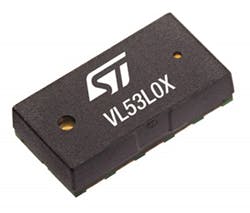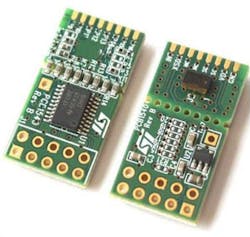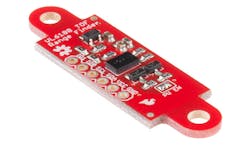About a year ago, a coworker told me about a new kind of distance sensor that one of our electronics distributors just told him about. I listened, half-distracted until he said that the sensor was the size of an IC and it worked by measuring the time it takes light emitted to bounce off of a target and return.
At this point I was thinking that my coworker didn’t understand how this device works. Did he even know how fast light traverses distance? At a distance of 2cm, you would have to be counting in picoseconds. I didn’t believe him when he said that a tiny QFN type (actually an LGA) package could do all that completely by itself.
Later, after everyone had calmed down, I found out that my coworker was talking about the VL53L0X and VL6180X from STMicroelectronics. Billed as the smallest laser-ranging modules available, they really do function the way my coworker said they did.
How Do These Sensors Work?
A VCSEL (vertical-cavity surface emitting laser) emits an eye-safe, Class 1 940nm beam. That wavelength is virtually imperceptible to the human eye. The beam hits an object, and a small portion of the beam’s energy is reflected back to the SPAD housed within the device. The SPAD or single-photon avalanche diode is a special type of photo sensor that can detect and amplify very minute signals—even signals composed of just one photon. The time between VCEL emission and the triggering of the SPAD is counted to give the time-of-flight of the returning light. Given the ToF and knowing that the speed of light in air is just about 299,700,000 meters per second (slightly slower than c in a vacuum—299,792,458 meters per second), the distance is calculated:
Distance = ToF * cair
The microcontroller embedded in the ST devices handles all calculations and noise reduction and sends it back to you via a single I2C connection. Thresholds and noise tolerance can be adjusted via I2C as well.
They report that this method can range an object independent of its reflectivity. How would these devices handle an extremely low albedo object like a piece of charcoal?
The VL6180X measures a range of 0cm to 10cm and the VL53L0X can do about 4cm to 200cm. Practically speaking, temperature and atmospheric conditions are going to affect those numbers. These devices also have several user selectable modes of operation where sampling and reporting speed can be sped up at the expense of sensor resolution. Both devices have astonishing low current draws. At worst, the VL53L0X will draw 20mA, and the VL6180X will draw an incredibly low 1.7mA.
Where the Sensors Are Used
When I was first turned onto these SoC ToF sensors, I was told that a large part of the expected market was range finders in cell phones. The sensors would detect the presence of the operator’s head and use that information to determine when to tune the screen off so that your ear didn’t tap buttons on the screen. I am aware of at least one manufacturer that intends to use the sensor to turn on the screen at a kiosk when a customer approaches. Robots, bathroom appliances, gesture recognition, and automation are all potential niches for these devices. They can be applied literally to anything and anywhere that can benefit from accurate, low-cost range finding.
Getting Started
You could order a single unmounted chip from a distributor, but then you have to complete a project of mounting the chip along with any necessary support components. You are better off buying a chip already mounted to a board. ST, of course, has a kit available composed of what they refer to as a satellite board. Each kit comes with two boards, and they are surprisingly inexpensive for a manufacturer-supplied dev board.
Perhaps easier to use and offering a bit more in the way of fellow user experience to draw from are the dev boards offered by SparkFun, Adafruit, and Pololu.
Purchased individually, the devices sell for around $6 each, but these modules or their successors will undoubtedly get cheaper and better with time as happens with every other type of electronic device. Distance sensors and ToF sensors are, of course, nothing new but tiny, all-in-one surface-mount modules definitely bring sci-fi technology to the present day. I am looking forward to the day when a sensor this size can effectively range objects out to 100 meters.
ST has patented its ranging methods under what it calls FlightSense technology, and for now, they seem to be the only ones offering a range sensor in such a compact package. How long that patent will be an impediment to competition remains to be seen.






